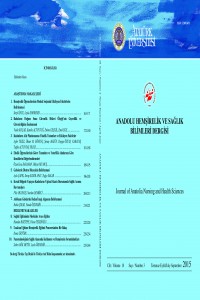Öz
Determination of The Level of Distress in Pregnant Women Objective: The aim of this study is to determine the level of distress in pregnant women.Method: Population of this descriptive study consisted of all the pregnant women who applied to the NST Department of Maternity Hospital in the Erzurum between January-September 2014. 914 pregnant women who complied with the inclusion criteria of the study and accepted to participate in the study constituted the sample group of the study. Personal Information Form and Tilburg Pregnancy Distress Scale were used for data collection. Evaluation of the data; percentage, mean, t-test and one-way analysis of variance (ANOVA) was used. Results: The average age of the women was 26.69±4.92. 40.8% of these women were primary school graduate; 33.4% had their first pregnancy, 85.9% was planned the pregnancy. The distress mean score of the pregnant women was 18.86±7.37. According to the cut-off point; 11.9% of these pregnant women experienced distress (stress, anxiety, and depression). In pregnant women; it was determined that while age, income status, spouse occupation, and pregnancy planning status affect the distress scores; education level, occupation, spouse's education level, family type, number of pregnancies and number of children not affect. Conclusion: According to the results obtained from the study, it was specified that the distress was at a significant level during pregnancy. Distress is affected by age, income status, spouse occupation, and pregnancy planning status
Anahtar Kelimeler
Öz
ÖZET
Amaç: Çalışmanın amacı gebelerde distres düzeyinin belirlenmesidir.
Yöntem: Tanımlayıcı tipteki çalışmanın evrenini Erzurum Kadın Doğum Hastanesi NST birimine Ocak-Eylül 2014 tarihleri arasında başvuran gebeler oluşturmaktadır. Çalışma kriterlerine uyan ve çalışmaya katılmayı kabul eden 914 gebe örneklemi oluşturmuştur. Veriler, Kişisel Bilgi Formu ve Tilburg Gebelikte Distres Ölçeği kullanılarak toplanmıştır. Verilerin değerlendirilmesinde; yüzdelik, ortalama, t testi ve tek yönlü varyans analizi (ANOVA) kullanılmıştır.
Bulgular: Kadınların yaş ortalaması 26.69±4.92’dir. %40.8’i ilkokul mezunu, %33.4’ü ilk gebeliğine sahip, %85.9’u gebeliğini planlamıştır.
Gebelerin distres puan ortalaması 18.86±7.37’dir. Kesme noktasına göre, gebelerin %11.9’unun distress (stress, anksiyete ve depresyon) yaşadığı saptanmıştır. Gebelerde; yaş, gelir durumu, eş mesleği ve gebeliğin planlanma durumunun distres puanını etkilediği, eğitim düzeyi, meslek, eş eğitim düzeyi, aile tipi, gebelik sayısı ve çocuk sayısının ise distres puanını etkilemediği belirlenmiştir.
Sonuçlar: Çalışmadan elde edilen bulgulara göre gebelikte distresin önemli düzeyde olduğu saptanmıştır. Distres yaş, gelir durumu, eş mesleği ve gebeliğin planlanma durumu tarafından etkilenmektedir.
Anahtar kelimeler: Gebelik; distres; depresyon; ebelik.
ABSTRACT
Determination of The Level of Distress in Pregnant Women
Objective: The aim of this study is to determine the level of distress in pregnant women.
Method: Population of this descriptive study consisted of all the pregnant women who applied to the NST Department of Maternity Hospital in the Erzurum between January-September 2014. 914 pregnant women who complied with the inclusion criteria of the study and accepted to participate in the study constituted the sample group of the study. Personal Information Form and Tilburg Pregnancy Distress Scale were used for data collection. Evaluation of the data; percentage, mean, t-test and one-way analysis of variance (ANOVA) was used.
Results: The average age of the women was 26.69±4.92. 40.8% of these women were primary school graduate; 33.4% had their first pregnancy, 85.9% was planned the pregnancy.
The distress mean score of the pregnant women was 18.86±7.37. According to the cut-off point; 11.9% of these pregnant women experienced distress (stress, anxiety, and depression). In pregnant women; it was determined that while age, income status, spouse occupation, and pregnancy planning status affect the distress scores; education level, occupation, spouse's education level, family type, number of pregnancies and number of children not affect.
Conclusion: According to the results obtained from the study, it was specified that the distress was at a significant level during pregnancy. Distress is affected by age, income status, spouse occupation, and pregnancy planning status.
Keywords: Pregnancy; distress; depression; midwifery.
Anahtar Kelimeler
Ayrıntılar
| Birincil Dil | Türkçe |
|---|---|
| Bölüm | Makaleler |
| Yazarlar | |
| Yayımlanma Tarihi | 5 Nisan 2015 |
| Gönderilme Tarihi | 5 Nisan 2015 |
| Yayımlandığı Sayı | Yıl 2015 Cilt: 18 Sayı: 3 |
Cited By
Gebelikteki Yakınmaların Yaşam Kalitesine Etkisi ile Doğum Korkusu ve Stres Arasındaki İlişki
Ankara Sağlık Bilimleri Dergisi
https://doi.org/10.46971/ausbid.1541009
HİPEREMEZİS GRAVİDARUM TANISI ALAN GEBELERİN KİŞİLİK ÖZELLİKLERİNİN BULANTI VE KUSMAYA ETKİSİ
Fenerbahçe Üniversitesi Sağlık Bilimleri Dergisi
https://doi.org/10.56061/fbujohs.1344438
Gebelerde prenatal bağlanma ve distres düzeylerinin değerlendirilmesi
Anatolian Journal of Health Research
https://doi.org/10.61534/anatoljhr.1446349
Gebeliğin İstenme Durumu ile Gebelik Distresi ve Prenatal Bağlanma Arasındaki İlişkisinin İncelenmesi
Sağlık Bilimleri Üniversitesi Hemşirelik Dergisi
https://doi.org/10.48071/sbuhemsirelik.1383963
Gebelikte Yaşanan Distresin Prenatal Bağlanmaya Etkisi
Balıkesır Health Sciences Journal
https://doi.org/10.53424/balikesirsbd.1138887
Determination of distress, emotional eating and internalized weight bias levels of Turkish pregnant women
Journal of Obstetrics and Gynaecology
https://doi.org/10.1080/01443615.2022.2153020
Identification of Distress Levels in Pregnant Women: A Descriptive and Cross-Sectional Study
Turkish Journal of Family Medicine and Primary Care
https://doi.org/10.21763/tjfmpc.699627
Gebelikte DistresinTanımlanması:Erzincan Örneği
Mehmet Akif Ersoy Üniversitesi Sağlık Bilimleri Enstitüsü Dergisi
https://doi.org/10.24998/maeusabed.518546
Investigation of the effects of distress on health practices in pregnant women
Erzincan Üniversitesi Fen Bilimleri Enstitüsü Dergisi
https://doi.org/10.18185/erzifbed.1201964
Use of Mobile Applications by Pregnant Women and Levels of Pregnancy Distress During the COVID-19 (Coronavirus) Pandemic
Maternal and Child Health Journal
Sultan Özkan Şat
https://doi.org/10.1007/s10995-021-03162-y
INVESTIGATION OF THE PRENATAL ATTACHMENT LEVELS OF PREGNANT WITH DEPRESSIVE SYMPTOMS
Turkish Journal of Science and Health
Simge SEZENLER
https://doi.org/10.51972/tfsd.886925
Aile Sağlığı Merkezi’ne Hizmet Almaya Gelen Gebelerin Psikososyal Sağlık Düzeyleri ve Etkileyen Faktörler
Adnan Menderes Üniversitesi Sağlık Bilimleri Fakültesi Dergisi
Tülay DOĞRUSOY
https://doi.org/10.46237/amusbfd.881021
Gebelikte Yaşanan Distres ile Gebelikteki Yakınmalar ve Yaşam Kalitesi Arasındaki İlişki
Jinekoloji-Obstetrik ve Neonatoloji Tıp Dergisi
Fatma AKPINAR
https://doi.org/10.38136/jgon.683745
Socio-demographic and pregnancy-related characteristics associated with prenatal distress: a Turkish study
Central European Journal of Nursing and Midwifery
Emel Bahadir Yilmaz
https://doi.org/10.15452/CEJNM.2019.10.0016
Dergimiz 2019 dan itibaren EBSCO CINAHL Database'de listelenmektedir.
Anadolu Hemşirelik ve Sağlık Bilimleri Dergisi Creative Commons Attribution-NonCommercial 4.0 (CC BY-NC 4.0) ile lisanslanmıştır.


